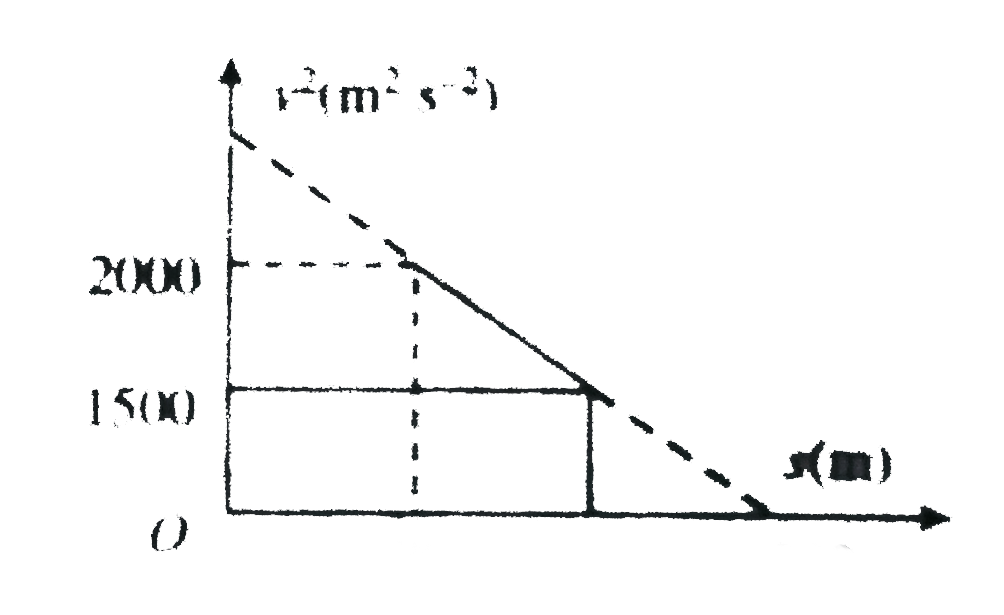A particle having initial velocity 4 m/s moves with a constant acceleration 1m/s2 for a time interval of 10 second in straight line. Find the displacement of the particle in the last second and the distance travelled in 10 second.
To solve the problem, we will break it down into two parts: finding the displacement of the particle in the last second and calculating the total distance travelled in 10 seconds.
Step 1: Calculate the Displacement in the Last Second
To find the displacement of the particle in the last second (10th second), we can use the formula for displacement in the nth second:
sn=u+a2⋅(2n−1)
Where:
- sn = displacement in the nth second
- u = initial velocity
- a = acceleration
- n = time interval in seconds
Given:
- u=4m/s
- a=1m/s2
- n=10
Substituting the values into the formula:
s10=4+12⋅(2⋅10−1)
Calculating inside the parentheses:
s10=4+12⋅(20−1)=4+12⋅19
Calculating 192:
s10=4+9.5=13.5meters
Step 2: Calculate the Total Distance Travelled in 10 Seconds
To find the total distance travelled in 10 seconds, we can use the formula:
s=ut+12at2
Where:
- s = total distance travelled
- u = initial velocity
- t = total time
- a = acceleration
Given:
- u=4m/s
- a=1m/s2
- t=10s
Substituting the values into the formula:
s=4⋅10+12⋅1⋅(10)2
Calculating each term:
s=40+12⋅1⋅100
Calculating 1002:
s=40+50=90meters
Final Answers:
- Displacement in the last second: 13.5 meters
- Total distance travelled in 10 seconds: 90 meters
---
- sn = displacement in the nth second
- u = initial velocity
- a = acceleration
- n = time interval in seconds
- u=4m/s
- a=1m/s2
- n=10
- s = total distance travelled
- u = initial velocity
- t = total time
- a = acceleration
- u=4m/s
- a=1m/s2
- t=10s
- Displacement in the last second: 13.5 meters
- Total distance travelled in 10 seconds: 90 meters
Topper's Solved these Questions
- MOTION IN STRAIGHT LINEBook:AAKASH INSTITUTE ENGLISHChapter:MOTION IN STRAIGHT LINEExercise:Try Yourself
Explore 40 Videos
- MOTION IN STRAIGHT LINEBook:AAKASH INSTITUTE ENGLISHChapter:MOTION IN STRAIGHT LINEExercise:Assignment (SECTION - A)
Explore 50 Videos
- MOTION IN A STRAIGHT LINEBook:AAKASH INSTITUTE ENGLISHChapter:MOTION IN A STRAIGHT LINEExercise:ASSIGNMENT (SECTION - D)
Explore 15 Videos
- MOVING CHARGE AND MAGNESIUMBook:AAKASH INSTITUTE ENGLISHChapter:MOVING CHARGE AND MAGNESIUMExercise:SECTION D
Explore 16 Videos
Similar Questions
A particle having initial velocity u moves with a constant acceleration a for a time t. a. Find the displacement of the particle in the last 1 second . b. Evaluate it for u=5m/s,a=2m/s2andt=10s.
View SolutionVelocity time graph for a particle moving in a line is given.
Calculate the displacement of the particle and distance travelled in first 4 seconds.

View SolutionA particle has an initial velocity of 9m/s due east and a constant acceleration of 2m/s2 due west. The distance coverd by the particle in the fifth second of its motion is :
View SolutionIf body having initial velocity zero is moving with uniform acceleration 8m/sec2 the distance travelled by it in fifth second will be
View SolutionReferrring to the v2−s diagram of a particle, find the displacement of the particle durticle during the last two seconds.
 .
.
View SolutionA particle starts from rest, moving in a straight line with a time varying acceleration (inm/s2):a=30−152√t, where time is in seconds . The displacement of the particle in 4 seconds is .
View SolutionA particle moving along a straight line with a constant acceleration of −4m/s2 passes through a point A on the line with a velocity of +8m/s at some moment. Find the distance travelled by the particle in 5 seconds after that moment.
View SolutionA particle initially at rest, moves with an acceleration 5 m s−2 for 5 s. Find the distance travelled in (a) 4 s, (b) 5 s and (c) 5th second.
View SolutionA body starts from rest and accelerates with 4m/s2 for 5 seconds. Find the distance travelled with 5 seconds.
View SolutionConsider a particle intially moving with a velocity of 5 m s−1 starts decelerating at a constant rate of 2 m s−2.
a. Determine the time at which the particle becomes stationary.
b. Find the distance travelled in the second second.
c. Find the distance travelled in the third second.
View Solution